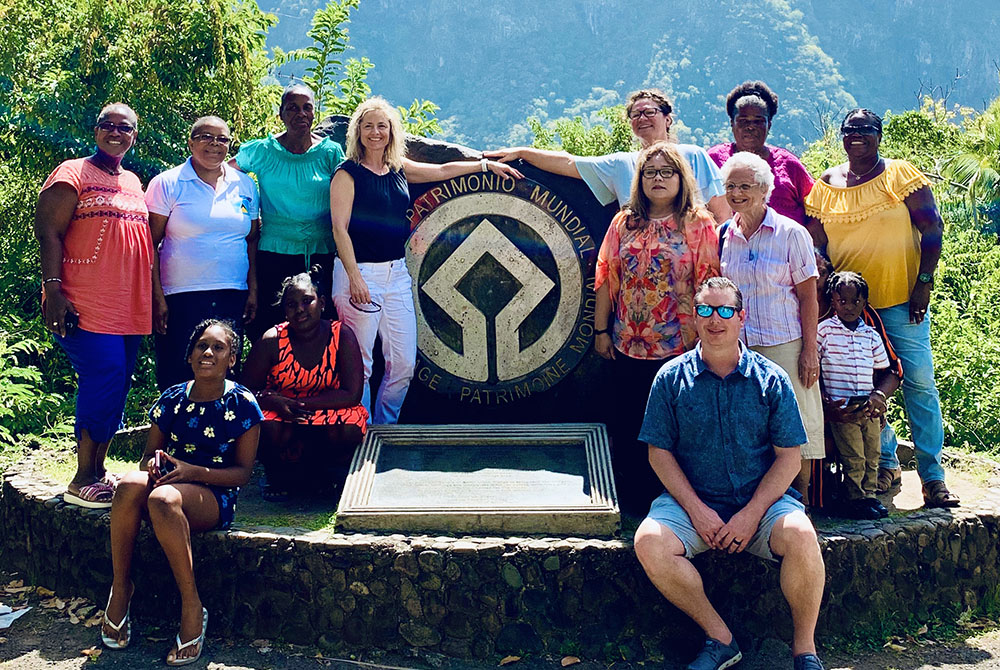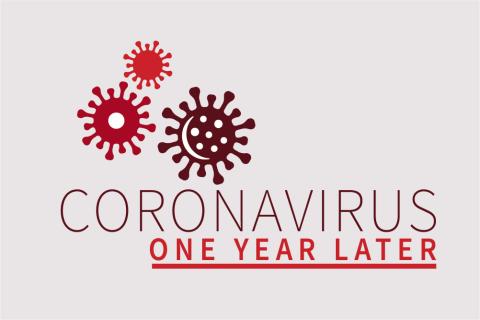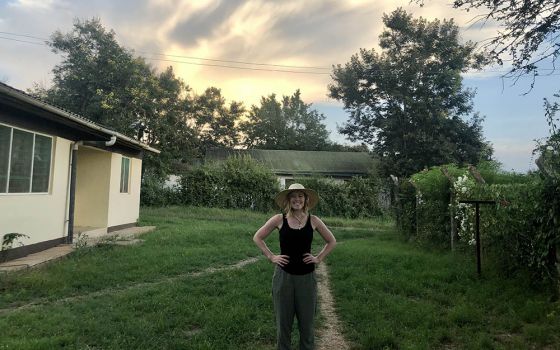
Parishioners from St. Michael's Parish in Mt. Orab, Ohio, visit twinning partners who are part of the Archdiocese of Castries on the Caribbean island of St. Lucia in February 2020. The next month the World Health Organization said COVID-19 could be characterized as a pandemic. (Courtesy of the missions office of the Archdiocese of Cincinnati)

(NCR, GSR logo/Toni-Ann Ortiz)
Last January, Mike Haasl and his Minnesota-based parish, St. Gerard's, took a seven-day trip to Matamoros, Mexico and Brownsville, Texas, along the Mexico-U.S. border. There, San Rafael, a sister parish based in Mexico met them.
They spent a day in Matamoros speaking to people who had been deported from the U.S. and with refugees awaiting permission to enter the country. On the other side, the two churches spent time with organizations and individuals working with the Diocese of Brownsville to provide shelter and food to refugees who had recently entered the U.S. Meanwhile, they learned about the border wall and how, for example, it is affecting the area's ecology.
"That was a phenomenal visit, to hear reflections from both sides," said Haasl, who was previously the global solidarity coordinator for the Archdiocese of St. Paul and Minneapolis. "I don't think any other parish in our diocese had done quite something like this."
Today, the potential for such a powerful experience is almost completely nonexistent. Parishes involved in "sister" or "twinning" relationships cannot visit each other as they routinely do, due to COVID-19 travel restrictions. Some are struggling with the disruption, while others are finding creative ways to manage it.
Dan Suer said the latter category applies to St. Maximilian Kolbe Parish in Liberty Township, Ohio, and its relationship with St. Patrick's Madera in Soroti, Uganda. Communication between the two parishes hasn't dwindled. If anything, it has become more regular. "I think the glue of our relationship is the ability to have WhatsApp calls on a weekly basis, sometimes biweekly," said Suer, chair of St. Max's parish twinning committee.
For the two churches, it hasn't been as difficult to communicate using technology because they have been doing it since their partnership began in 2018. From the start, they have used WhatsApp, email and handwritten letters to keep up with each other. Only once have they met in person.
Each twinning relationship can look different, explained Mike Gable, director of the Archdiocese of Cincinnati's mission office. Sometimes, parishes in different countries pair up or ones in the same country do. Other times, two dioceses partner with each other. The agreements between some are more informal, while others, such as St. Max and St. Patrick, is based on a literal contract. A more universal trait, though, is travel, Gable said.
Yet St. Max and St. Patrick started their partnership a year and a half before St. Max members visited Uganda, which they did for the first time last March right before the pandemic started. Though the two parishes developed a bond before then, the trip was critical. "It [the partnership] didn't really take off until people were on the ground," Suer said.
In Uganda, St. Max members met with the local bishop, participated in a St. Patrick's Day Mass and deepened connections with other church leaders. Those new connections were crucial to furthering conversations after St. Max members departed Uganda. In those follow-up WhatsApp calls, the two parishes brainstormed a new idea for St. Max members to fundraise and help St. Patrick members purchase oxen and plows to assist their farming. The fundraiser ultimately helped 186 families in Soroti.
Advertisement
For Gable, the longevity of St. Max's and St. Patrick's relationship, and the impact the two have on each other, demonstrates a "solidarity-based model," an approach the missions director is trying to teach more churches in the diocese about. "In solidarity, we stick with people for the longer term. That's why I'm not big on missions trips. Missions trips are too often like a flash in the pan," Gable said.
Another parish in the diocese, Church of the Ascension in Kettering, desires a more intertwined relationship with its twinning partner in Lima, Peru, but has found it challenging lately. "There are a variety of things that sometimes didn't flow the way we thought they were going to flow," said Steven Mueller, who serves on the parish twinning committee. "Then COVID just made it a lot more difficult."
Mueller and other committee members explained that they had become disconnected with Our Lady of the Light Parish in Lima prior to the pandemic. There was a change in leadership at the Peruvian church, and a construction accident at the church building led the parish to shift its priorities.
Now, with the coronavirus, it's been difficult to maintain a long-distance relationship. "A lot of time, it's a challenge to get people from our parish to interact remotely," said committee member Javier Hopun. Hopun is one of the only Church of the Ascension members who regularly uses WhatsApp to talk with people at Our Lady of the Light.
Several of the committee members at Church of the Ascension said COVID-19 has been a bump in the road. "Even though the relationship theoretically goes back 20 years, we're kind of starting over," said committee member Kathy Lindahl. The two churches have been twinning since 1999.
They haven't given up, though. They want to livestream a Mass on Facebook for Our Lady of the Light members to watch. They also are planning to shoot a video tour of Church of the Ascension to send Our Lady of the Light and are hoping people down there will do the same. Meanwhile, the Church of the Ascension regularly prays for Our Lady of the Light at Mass. "My focus now is trying to do things to develop, first, some kind of relationship, but [furthermore], a spiritual relationship. And making those more concrete," Lindahl said.
Church of the Ascension isn't alone. Gable facilitated a Zoom meeting on Jan. 19 that brought together parish twinning committee members at several churches within the Archdiocese of Cincinnati to brainstorm ways to deepen relationships despite the current situation. They were also joined by a member of Our Lady of Guadalupe parish in El Salvador, which is twinning with St. John the Baptist in Cincinnati. During the Zoom meeting, the Our Lady of Guadalupe/St. John the Baptist team talked about forming a delegation to oversee regular, virtual meetings between parishioners. They are also looking for ways to connect St. John the Baptist members with kids they sponsor at Our Lady of Guadalupe.
Haasl, who oversaw sister parish relationships at the Archdiocese of St. Paul and Minneapolis for 18 years, said it's understandable the challenges churches are having right now. "Visits are fundamental to building these relationships. So, if you can't do a face-to-face visit, it's hard to maintain relationships," he said.
At the same time, if churches are up for the challenge and can communicate more regularly through remote means — amidst differences in time zones or complications with technology — then this moment could be really productive, Haasl said. It doesn't come easily, though.
"If it has not been a long-term relationship and if it's not fundamentally about relationship, then I think it's going to fall," Haasl said. "There is tremendous capacity and potential, but we just don't achieve it … unless we're intentional about it from the beginning."
[Liam Adams is a Denver-based freelance reporter writing about religion. His work has also been featured in The Chronicle of Higher Education, Religion News Service, Sojourners, Baptist News Global and Christianity Today.]





